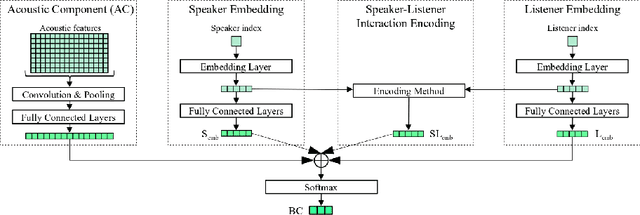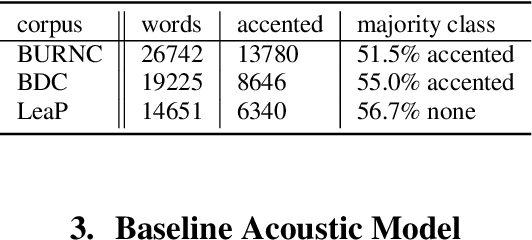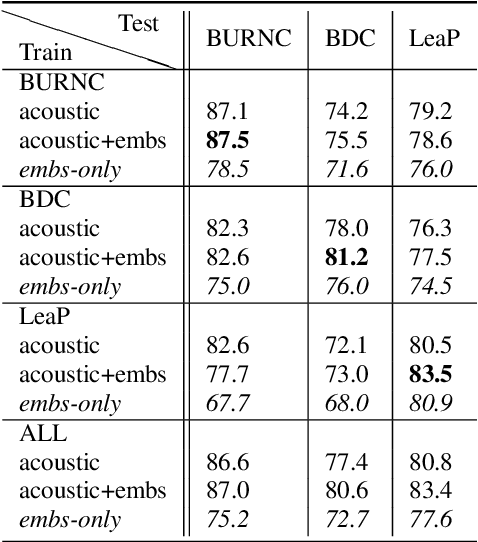Antje Schweitzer
The IMS Toucan System for the Blizzard Challenge 2023
Oct 26, 2023Abstract:For our contribution to the Blizzard Challenge 2023, we improved on the system we submitted to the Blizzard Challenge 2021. Our approach entails a rule-based text-to-phoneme processing system that includes rule-based disambiguation of homographs in the French language. It then transforms the phonemes to spectrograms as intermediate representations using a fast and efficient non-autoregressive synthesis architecture based on Conformer and Glow. A GAN based neural vocoder that combines recent state-of-the-art approaches converts the spectrogram to the final wave. We carefully designed the data processing, training, and inference procedures for the challenge data. Our system identifier is G. Open source code and demo are available.
Modeling Speaker-Listener Interaction for Backchannel Prediction
Apr 10, 2023



Abstract:We present our latest findings on backchannel modeling novelly motivated by the canonical use of the minimal responses Yeah and Uh-huh in English and their correspondent tokens in German, and the effect of encoding the speaker-listener interaction. Backchanneling theories emphasize the active and continuous role of the listener in the course of the conversation, their effects on the speaker's subsequent talk, and the consequent dynamic speaker-listener interaction. Therefore, we propose a neural-based acoustic backchannel classifier on minimal responses by processing acoustic features from the speaker speech, capturing and imitating listeners' backchanneling behavior, and encoding speaker-listener interaction. Our experimental results on the Switchboard and GECO datasets reveal that in almost all tested scenarios the speaker or listener behavior embeddings help the model make more accurate backchannel predictions. More importantly, a proper interaction encoding strategy, i.e., combining the speaker and listener embeddings, leads to the best performance on both datasets in terms of F1-score.
"splink" is happy and "phrouth" is scary: Emotion Intensity Analysis for Nonsense Words
Apr 05, 2022



Abstract:People associate affective meanings to words - "death" is scary and sad while "party" is connotated with surprise and joy. This raises the question if the association is purely a product of the learned affective imports inherent to semantic meanings, or is also an effect of other features of words, e.g., morphological and phonological patterns. We approach this question with an annotation-based analysis leveraging nonsense words. Specifically, we conduct a best-worst scaling crowdsourcing study in which participants assign intensity scores for joy, sadness, anger, disgust, fear, and surprise to 272 non-sense words and, for comparison of the results to previous work, to 68 real words. Based on this resource, we develop character-level and phonology-based intensity regressors. We evaluate them on both nonsense words and real words (making use of the NRC emotion intensity lexicon of 7493 words), across six emotion categories. The analysis of our data reveals that some phonetic patterns show clear differences between emotion intensities. For instance, s as a first phoneme contributes to joy, sh to surprise, p as last phoneme more to disgust than to anger and fear. In the modelling experiments, a regressor trained on real words from the NRC emotion intensity lexicon shows a higher performance (r = 0.17) than regressors that aim at learning the emotion connotation purely from nonsense words. We conclude that humans do associate affective meaning to words based on surface patterns, but also based on similarities to existing words ("juy" to "joy", or "flike" to "like").
Effects of Word Embeddings on Neural Network-based Pitch Accent Detection
Jun 07, 2018



Abstract:Pitch accent detection often makes use of both acoustic and lexical features based on the fact that pitch accents tend to correlate with certain words. In this paper, we extend a pitch accent detector that involves a convolutional neural network to include word embeddings, which are state-of-the-art vector representations of words. We examine the effect these features have on within-corpus and cross-corpus experiments on three English datasets. The results show that while word embeddings can improve the performance in corpus-dependent experiments, they also have the potential to make generalization to unseen data more challenging.
 Add to Chrome
Add to Chrome Add to Firefox
Add to Firefox Add to Edge
Add to Edge